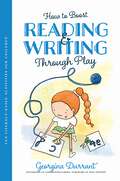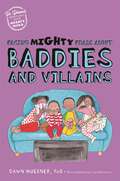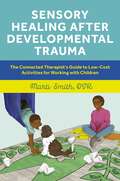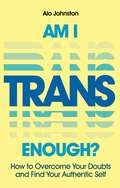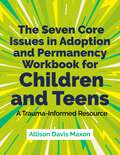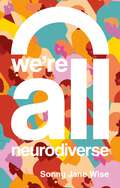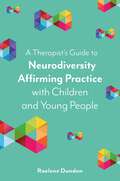- Table View
- List View
Nada Yoga: The Vibratory Essence of the Yoga of Sound
by Ananda Balayogi Bhavanani Dr Sangeeta BiagiNada Yoga may be translated as the Yoga of Vibration and Sound. Its teachings are both ancient and applicable to our contemporary Yoga practice as they help refine our inner listening skills and support the healthy expression of our voice. This contemporary manual offers clarity and guidance on Nada Yoga and fuses traditional teachings with modern science in a multicultural and multimedia approach. Authored by an experienced and dynamic author duo who are well versed in yoga therapy, modern medicine, and music, Dr Ananda Balayogi Bhavanani and Dr Sangeeta Laura Biagi bring a variety of novel approaches and methodologies to help students understand the advanced meditative techniques required for Nada Yoga and the principles behind them.It will include a comprehensive overview of Nada Yoga, the Pranava AUM, the Chakras, Carnatic Music Essentials, Relaxation and Healing, and Yoga Therapy Applications.
Trauma-Aware Yoga and Movement Therapeutics for Older Adults: Managing Common Conditions by Healing the Nervous System First
by Beth SpindlerDiscover the yoga and movement therapies at the heart of health in later life through this accessible guide for teachers and therapists.Beth Spindler has devised innovative movement practices based around acknowledging the trauma and vulnerability that come with a lifetime of memories. Trauma can exacerbate the effects of illnesses and conditions common in older adults, including depression, dementia, Parkinson's and arthritis. The movement and yoga therapeutics in this volume take a holistic approach to healing trauma alongside gentle practices to aide in managing symptoms in later life. Each chapter takes on a different condition or situation, explores how they can relate to trauma, and provides both the physical movement and the breathing exercises to address the issue.Complete with illustrations and adaptations for any setting or ability, the practices in this guide are suitable for many practitioners working with either individuals or groups.
How to Boost Reading and Writing Through Play: Fun Literacy-Based Activities for Children
by Georgina DurrantEven if children know their phonics and ABC's inside out and can read every book in their book bag, why is it still so difficult to get them to want to read and write? How do we begin to get our children excited about literacy? The answer might surprise you...let them play!Featuring 40 engaging play-based activities, this book makes literacy so fun that children won't notice they're also actively developing reading and writing skills. From blow painting words to making paper chain sentences, each activity can be done using household items and they are adaptable for children of any age and ability, making learning accessible for all. With charming black and white line illustrations to depict each activity, this is a great way to connect with children while helping to build their literacy skills at the same time.
Facing Mighty Fears About Baddies and Villains (Dr. Dawn's Mini Books About Mighty Fears #5)
by Dawn HuebnerWritten with warmth and humor, and filled with practical tips, this book eases over-size fears about real and baddies helping 6-10-year-olds live happier lives. Supplemental guidance for parents and caretakers ensures maximum effectiveness.
Trauma-Informed Art Activities for Early Childhood: Using Process Art to Repair Trauma and Help Children Thrive
by Anna ReynerWhy Art & Trauma? By making their own choices as they engage in sensory art experiences, children gain confidence, release stress, express emotions, and develop critical-thinking skills. Art offers a unique opportunity for children to safely experiment with the physical world and re-wire their brains to reduce the negative effects of trauma, all while learning to identify as creative thinkers. This highly illustrated and easy-to-use resource supports trauma-informed work with children ages 3-8. It delves into both the theory and practice of therapeutic art and includes 21 original art lessons and 60 art techniques, all presented visually for ease of use. Both text and illustrations demonstrate how to create a safe, non-retraumatizing environment for children to experience safety, connection and calm. Ideal for implementing into classroom environments, including preschools, kindergarten, early primary grades, afterschool programs, child counselling centers and community-based youth programs, this professional resource is perfectly adaptable for a variety of educational and therapeutic contexts.
Chinese Medicine and the Management of Hypermobile Ehlers-Danlos Syndrome: A Guide for Practitioners
by Paula BrunoHypermobility syndromes are more common, complex and varied than most practitioners realise. Every hypermobile patient is unique, and therefore challenging to treat using a pre-set paradigm or protocol. The hEDS population can be underserved by Western medicine and there is much that Chinese medicine can do for this community. This book is one of the first of its kind - a Chinese Medicine text focusing specifically on hypermobile Ehlers-Danlos Syndrome. Presenting existing bio-medical narratives before providing an in-depth exploration of the Chinese Medicine paradigms, this guide gives an overview of comprehensive treatment scenarios and addresses issues faced by EDS patients including pain management, psycho-emotional challenges, disruption of gut health, and chronic inflammation, including post-Lyme syndrome.
Sensory Healing after Developmental Trauma: The Connected Therapist’s Guide to Low-Cost Activities for Working with Children
by Marti SmithIn using this resourceful guide, therapists can develop a comprehensive understanding of how trauma impacts their young clients' brains and sensory systems. Filled with therapeutic strategies and activities tailored to specific regions of the brain, professionals will be able to optimise brain rehabilitation and improve sensory processing abilities.The book includes a wide range of low-cost, budgeted activities that can be applied in a variety of settings, including juvenile justice, rehab, schools, homes, residential care, and foster homes, all of which include guidance on how to engage the wider community in order to maximise the potential for healing.Complete with the latest research on trauma and real-life case studies, this book provides an excellent foundation on understanding the science and applying it in practice. It is an indispensable resource for paediatric caregivers looking to support the children they're working with in healing the impact of trauma.
The QCS Pool Activity Level: A Practical Resource for Carers of People with Cognitive Impairment Fifth Edition (University of Bradford Dementia Good Practice Guides)
by Jackie PoolThe QCS Pool Activity Level (PAL) Instrument is widely used as the framework for providing activity-based care for people with cognitive impairments, including dementia. The Instrument was recommended for daily living skills training and activity planning in the National Institute for Clinical Excellence Clinical Guidelines for Dementia (NICE 2006). It is an essential resource for any practitioner or carer wanting to provide fulfilling occupation for clients with cognitive impairments.This fifth edition of The QCS Pool Activity Level (PAL) Instrument for Occupational Profiling retains the checklists and plans helpful in matching user's abilities with personal care and leisure activities and includes a new chapter co-written by Professor Lesley Collier on the revised 'PAL Engagement Measure' describing its use and validity. Including access to a digital version of the PAL instrument, it is an essential resource for any practitioner or carer wanting to provide fulfilling and meaningful occupation for clients with cognitive impairments.
Arriving Late: The lived experience of women receiving a late autism diagnosis
by Jodi Lamanna"The stories within this book tell of the journey women take to late autism diagnosis: stories of discovery, strength, self-awareness and belonging."An honest and eye-opening collection of stories from the lives of late diagnosed autistic women across the world, brought together with thoughtful observations from neurodivergent advocate, Jodi Lamanna. Exploring life before and after diagnosis and covering topics such as masking, social interaction, parenting and employment, this book provides much-needed insight into the challenges and successes of late diagnosed women. With chances for reflection on your own experiences, informative diagnosis tips and guidance on what can be done in the future to properly support autistic women, this is an essential read for late diagnosed women and those supporting them.
Can't Not Won't: A Story About A Child Who Couldn't Go To School
by Eliza FrickerEliza Fricker gets it. Deceptively simple, endearing, humorous and emotional illustrations following a family managing the early stages of school avoidance are designed to help paretns feel seen, and empathetic writing and guidance gives essential advice and tips on navigating school avoidance for parents and professioinals alike.
All Tangled Up in Autism and Chronic Illness: A guide to navigating multiple conditions
by Charli ClementIn this ground-breaking debut, Charli Clement combines their own experiences alongside unique short profiles from individuals with chronic illness, to provide an intimate and insightful look at the complexities of living as an autistic and chronically ill person. From navigating your diagnosis and healthcare, learning how to manage pain and your own sensory needs to dealing with ableism, medical misogyny and transphobia, Clement offers practical advice and delves into the unique challenges faced by individuals living in this intersection.With a focus on the unique neurodivergent experience and an exploration into disability pride and joy 'All Tangled Up in Autism and Chronic Illness' is a necessary and empowering resource for autistic and chronically ill people as well as for family members, friends, and healthcare professionals.
Am I Trans Enough?: How to Overcome Your Doubts and Find Your Authentic Self
by Alo JohnstonAm I Trans Enough? The answer is undoubtably yes. You are.Alo Johnston has been where you are. From watching every transition story on YouTube and navigating online message boards for answers to finally starting testosterone and transitioning himself, he now walks alongside you every step of the way to guide you towards acceptance of who you truly are.Born out of thousands of hours of research and conversations with hundreds of trans people, Am I Trans Enough? digs deep into internalized transphobia and the historical narratives that fuel it. It unveils what happens after you come out, or begin questioning living as a trans person, in a world that works against you.Use this book as a space to engage with your fears and explore your doubts without the pressure of needing to be a perfect trans representative. If you are just beginning your trans journey, are twenty years into transition or have no idea if you are even trans at all, this book will help you to become your most authentic self.
ACT for Burnout: Recharge, Reconnect, and Transform Burnout with Acceptance and Commitment Therapy
by Debbie Sorensen"I know what it's like to care deeply about my work and yet feel utterly exhausted by it."Burnout is more widespread than ever before, and it's time to do something about it.Rooted in Acceptance and Commitment Therapy (ACT), this book delves into the systemic, cultural, and economic contexts that contribute to burnout, and gives you the tools to exit the cycle. Exercises and reflection questions help you reconnect with your values to find what's really important, and disentangle yourself from unhelpful thought patterns. By engaging with your emotions rather than avoiding or suppressing them, ACT allows you to respond more effectively and become re-engaged in your own life again. This book will show you how to move out of the burnout cycle, reconnect with meaningful aspects of your work, and make changes that last.
The Mental Health and Wellbeing of Children and Young People with Learning Difficulties: A Guide for Educators
by Kirstie ReesKnowing when children and young people are struggling, and identifying the best ways of supporting them is vital. This is all the more important when working with children with varying learning difficulties who may not always be able to communicate their feelings.By demystifying terms such as mental health, wellbeing, learning difficulties and the sensitivities surrounding labels, this practical and evidence-based guide helps you achieve an in-depth understanding of the children and young people you work with. It provides you with skills and knowledge for supporting their mental health and wellbeing in educational settings - from nursery to secondary school in both mainstream and specialist environments with talking and non-verbal communication approaches to accommodate varying needs. Most importantly its holistic approach explores the interaction between the child's learning difficulties and the psychological, social and environmental factors which influence how they manage their ups and downs in life. This lets you think beyond the child and the classroom.
Becoming a Trauma-informed Restorative Educator: Practical Skills to Change Culture and Behavior
by Margaret Thorsborne Joe BrummerMaybe you have heard the terms 'trauma-informed' and 'restorative' - but how do you go about becoming a trauma-informed, restorative educator? This practical book outlines the values, ideas and neuroscience behind trauma-informed restorative practice and its proven effectiveness. It clearly explains key theories relating to shame, trauma and your autonomic nervous system, and explains how to apply this knowledge in practice. Examples and stories of restorative practice feature throughout to inspire and emulate, as do practical protocols, tools and systems to develop your skills as a trauma-informed educator. Critically, it also explains the personal and professional qualities you need to nurture to truly engage in trauma-informed, restorative practice, with reflection points to aid learning and self-development. Read this book and take your first steps to creating a trauma-informed, restorative classroom - even if your school isn't doing it!
Therapy in Colour: Intersectional, Anti-Racist and Intercultural Approaches by Therapists of Colour
by VariousIf you are seeking to create a more intersectional, anti-racist, and inter-cultural approach to therapy, this edited collection emerging from the Black, African and Asian Therapy Network is an invaluable resource for your practice.This collection covers topics such as the psychological trauma of racism, the various barriers to accessing support for mental health and the lived experience of Black, African, or Asian people in a profession that is still dominated by Eurocentric perspectives, training, and practice. Each contribution further reinforces the importance and benefit of having an intersectional, anti-racist, and inter-cultural approach to your therapeutic practice and contains insight from 27 experts in the psychological arena.This book is split into four sections - the first focusses on colour, creativity, and anti-racist reflections. Part two covers training in the psychological field in the past, present, and future. Part three discusses CPD, supervision and self-care with a specific focus on mental, spiritual, physical, and emotional health and lastly, part five centralises therapeutic needs and psychological wellbeing within the context of identity, culture, and belonging.
The Seven Core Issues in Adoption and Permanency Workbook for Children and Teens: A Trauma-Informed Resource
by Allison Davis MaxonBased on the pioneering Seven Core Issues model, this resource is an accessible and age-appropriate way to support children and teens who have experienced early adversity, to strengthen understanding and healing. The Seven Core Issues are Loss, Rejection, Shame/Guilt, Grief, Identity, Intimacy and Mastery/Control. This resource combines two separate interactive workbooks - one for children developmentally aged 5-11, the other for children developmentally aged 12+. These can be filled in, photocopied or downloaded and provide a structured way for children and teens to explore their feelings and beliefs using exercises and activities. An ideal accompaniment to the Seven Core Issues Workbook for Parents of Traumatized Children and Teens, this resource will be valued by all adults supporting children who have experienced early adversity.
We're All Neurodiverse: How to Build a Neurodiversity-Affirming Future and Challenge Neuronormativity
by Sonny Jane Wise"Neurodiversity has helped me understand myself and provided a sense of relief that I'm a whole neurodivergent person functioning as my brain intends.""It's provided me with the language to advocate for myself.""I no longer hated myself. I no longer felt broken. I found a sense of community. A sense of belonging"This affirming and thoughtful guide outlines how and why we need to fundamentally shift our thinking about neurodivergent people. We need to accept differences rather than framing them as a problem, abnormality or disorder. Welcome to the neurodiversity paradigm.At times challenging and radical, Sonny Jane Wise explores the intersections of neurodivergence with disability, gender, sexuality and race. Through interviews, narratives, and the lens of their own raw experiences, they consider how current systems and structures that impact neurodivergent people are rooted in outdated capitalist and racist frameworks, and how these need to change and adapt to be neurodiversity affirming. Sonny Jane's words are a rallying cry to challenge the pathology paradigm. They offer nine principles for facilitating change, reflected in deeply personal stories from the neurodivergent community.Powerful and persuasive, this book is a clarion call for a kinder and more neurodiversity affirming society.
Acceptance and Commitment Therapy with Children: Applications and Strategies for Anxiety, Depression, Autism, ADHD, OCD and More
by Jodie WassnerAcceptance and Commitment Therapy (ACT) helps clients to embrace their feelings and use their personal values to improve their lives. Its popularity has grown significantly in recent years, but the number of ACT resources designed to support children is still limited. The ACT strategies and activities in this guide have been designed specifically for use with children aged 5-12, with a particular focus on the uniquely delicate connection needed for a successful practitioner-client relationship. The approach is designed to fit children's stages of development and learning styles, allowing young clients to build skills in a way that suits their age and cognitive patterns. Built from the author's extensive experience in child psychology, this guide offers ways to tailor ACT for effective work with children. It includes specific and detailed guidance on tailoring ACT to specific presentations, including OCD and neurodivergent populations, as well as parenting.
A Therapist’s Guide to Neurodiversity Affirming Practice with Children and Young People
by Raelene DundonIn this honest and practical guide, autistic therapist Raelene Dundon explores and demystifies how neurodiversity affirming principles can be easily applied to therapeutic practice.Covering essential considerations for working with neurodivergent clients such as presuming competence, promoting autonomy and respecting communication styles, and providing advice on the best affirming approaches in therapy including how to accommodate sensory needs and encourage self-advocacy, Raelene provides easy-to-implement ways to make your practice inclusive and empowering for neurodivergent children and young people.The deficit model is out. It's time to become neurodiversity affirming.
DBT for Everyone: A Guide to the Perks, Pitfalls, and Possibilities of DBT for Better Mental Health
by Michelle Henderson Kate ShermanDBT skills can be a fantastic way to approach life's challenges. But where do you start? This down-to-earth guide walks you through the four DBT modules, mindfulness, distress tolerance, emotion regulation, and interpersonal effectiveness. Each chapter explains how to practice the key skills and dives into the authors' own experiences to explore what works, what doesn't, and which skills work best for particular challenges. Journaling prompts help you work out how to fit the skills into your own day-to-day life, so you can make changes that work for you.DBT works by helping you to understand difficult emotions and develop skills to regulate them in a healthy way. Whether you struggle with mental health difficulties, or just want to improve the way you handle everyday stress and challenges, this book will filter out the jargon and show you how to use DBT skills in real life.
When Teens Self-Harm: How Parents, Teachers and Professionals Can Provide Calm and Compassionate Support
by Monika Parkinson Lucy Willetts Kerstin ThirlwallSupporting teens who self-harm can be stressful, with panic and anxiety muddying the waters and making it difficult to know how to respond. How do you help? What if you make it worse?This book guides you through the potential reasons for self-harming behaviour, helping you to respond with compassion and support. Quotes from young people who self-harm give insight into the mindset behind the behaviour, while expert guidance gives you the tools to help. Advice on regulating your own emotions, combined with a better understanding of why teens self-harm, allows you to provide a safe, nurturing environment to support your young person and reduce their self-harming behaviour.Grounded in the authors' extensive clinical experience in young people's mental health, this book guides you out of panic mode to create a secure, validating environment for teens who self-harm.
Cranial Osteopathy: TMJ and Mouth Disorders, and Cranial Techniques
by Torsten LiemTaking a detail-oriented, yet holistic approach to the body is the underpinning of craniosacral osteopathy. This richly illustrated guide, which focuses on the jaw joint, TMJ and mouth disorders disorders, and the facial skull, will help you understand how specific dysfunctions arise, but also how they interrelate to wider patterns of dysfunction. Further chapters cover palpatory procedures, including examples of best practice, and guidance in training your palpatory perception. With precise anatomical diagrams to illustrate each craniosacral technique, this resource provides a strong foundation for any successful cranial osteopathic practice.
Trauma-Informed Health Care: A Reflective Guide for Improving Care and Services
by Dr. Karen TreismanThis comprehensive reflective resource explores the values, principles and practical applications of trauma-informed and -infused health care. Trauma-Informed Health Care introduces the different types of trauma - including medical and health trauma - and the impact of adversities, social inequalities and stressors. It explores their effects on health and the body, and on people's relationships with health providers. Key issues addressed include the importance of cultural humility, the effects of secondary and vicarious trauma, burnout and moral injury. It also covers the critical issue of organizational trauma: how to avoid practice which has potential to traumatize or retraumatize, and the role of cultural understanding, language, leadership, staff wellbeing and the physical environment.Drawing substantially on the experiences of people who use services and active practitioners, this book spans diverse settings -- from doctor's surgeries to hospitals and allied health services. It reveals how "every interaction can be an intervention" and provides you with practical examples, graphics and reflective exercises to support you to bring about positive change.This book is perfect for anyone working in healthcare including midwives, nurses, doctors, dentists, occupational therapists, physiotherapists, radiographers, sonographers, health care assistants, play specialists, speech and language therapists, phlebotomists, psychologists, dieticians, audiologists, podiatrists and more.
Cranial Osteopathy: Special Sense Organs, Orofacial Pain, Headache, and Cranial Nerves
by Torsten LiemTaking a detail-oriented, yet holistic approach to the body, is the underpinning of craniosacral osteopathy. This richly illustrated guide, which focuses on the special sense organs, orofacial pain, headaches and cranial nerves, will help you understand how specific dysfunctions arise, but also how they interrelate to wider patterns of dysfunction. Further chapters cover palpatory procedures, including examples of best practice, and guidance in training your palpatory perception. With precise anatomical diagrams to illustrate each craniosacral technique, this resource provides a strong foundation for any successful cranial osteopathic practice.


